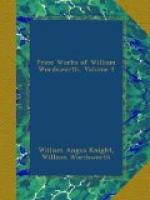’W. WORDSWORTH.’[49]
[49] Life of Scott, by Lockhart, vol. ii. 165-7 (1856). The following from the same source, earlier, may fitly find a place here: ’It was in the September of this year [1803] that Scott first saw Wordsworth. Their common acquaintance, Stoddart, had so often talked of them to each other, that they met as if they had not been strangers; and they parted friends. Mr. and Miss Wordsworth had just completed that tour in the Highlands of which so many incidents have since been immortalised, both in the poet’s sense and in the hardly less poetical prose of his sister’s Diary. On the morning of the 17th of September, having left their carriage at Rosslyn, they walked down the valley to Lasswade, and arrived there before Mr. and Mrs. Scott had risen. “We were received,” Mr. Wordsworth has told me, “with that frank cordiality which, under whatever circumstances I afterwards met him, always marked his manners; and, indeed, I found him then in every respect—except perhaps that his animal spirits were somewhat higher—precisely the same man that you knew him in later life; the same lively, entertaining conversation, full of anecdote, and averse from disquisition; the same unaffected modesty about himself; the same cheerful and benevolent and hopeful views of man and the world. He partly read and partly recited, sometimes in an enthusiastic style of chant, the first four cantos of the “Lay of the Last Minstrel;” and the novelty of the manners, the clear picturesque descriptions, and the easy glowing energy of much of the verse, greatly delighted me."’ (pp. 160-1).
27. The Grove: Captain John Wordsworth.
John Wordsworth left Grasmere on Michaelmas-day, 1800, walking over by Grisedale Tarn to Paterdale, whence he would proceed to Penrith; he took leave of his brother William, near the Tarn, where Ullswater first comes in view; and he went to sea again, in the Abergavenny East-Indiaman, in the spring of 1801.
After his departure from Grasmere, the Poet discovered a track which had been worn by his brother’s steps ‘pacing there unwearied and alone,’ during the winter weather, in a sheltering fir-grove above the cottage, and henceforth that fir-grove was known to the Poet’s household by the name of ‘John’s Grove,’ or ‘Brother’s Grove.’ Of this Wordsworth writes:
‘When to the attractions of the busy world,’ 1805.—’The grove still exists, but the plantation has been walled in, and is not so accessible as when my brother John wore the path in the manner described. The grove was a favourite haunt with us all while we lived at Town-End.’[50]
28. Spenser and Milton.
Captain Wordsworth returned from the voyage on which he sailed in 1801; and in November 1802, he writes for directions what books to buy to carry with him on a voyage of sixteen months....
[50] Memoirs, i. 282.
‘Tell John’ says Wordsworth, ’when he buys Spenser, to purchase an edition which has his “State of Ireland” in it. This is in prose. This edition may be scarce, but one surely can be found.




